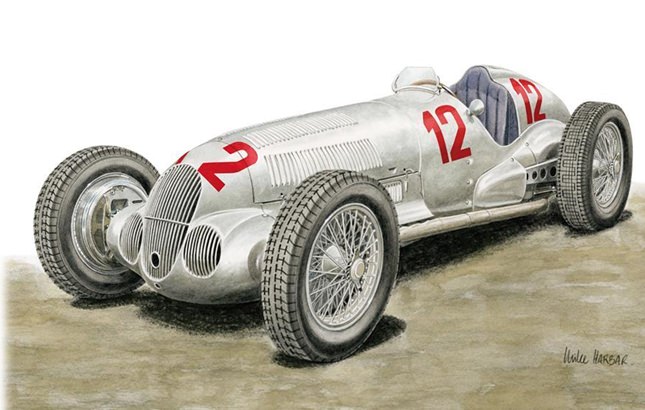
Pre-war Grand Prix racing was the playground of Mercedes and Auto-Union and whatever was left was picked up by Alfa Romeo.
1936 had belonged to Auto Union and especially their brilliant young driver Bernd Rosemeyer.
The Mercedes W25 was showing its age and Mercedes decided to temporarily withdraw from competition to reorganize their racing department. Rudolf Uhlenhaut was appointed Technical Director of the Rennabteilung, or racing department that would work between the Design Office and the Team Manager, Alfred Neubauer. Uhlenhaut was 30 years old at the time and decided that the only way for him to fully understand the problems with the Grand Prix Cars was to drive them himself. Soon he was lapping the Nurburgring at times just below the drivers. Grand Prix racing was different in those days as the cars were tested and re-tested constantly prior to the race meeting.
Once the cars arrived at the race meeting they were rarely changed and the weekend was used to familiarize the drivers with the track and local conditions. Uhlenhaut would be in charge of all racing development until they came to the track where Neubauer would handle race strategy. The most successful partnership in the history of motor racing had begun.
While testing the W25 Uhlenhaut found the chassis too weak and the springs to stiff! There was very little movement of the axle against the frame. On one occasion he lost a rear wheel on the straight at top speed. The car continued on as if nothing happened! He would later remark that “it was like driving a motorcycle with a sidecar!” The new car for the 1937 season would be based on the lessons learned during this test period. Intense testing of the car took place at Monza due to bad weather back in Germany. The car was driven for nearly 1,500 miles without any serious problems.
The W125 is considered a development of the W25 and so it should but the changes that Uhlenhaut made had a profound effect. The suspension was completely redesigned with the idea of providing softer front suspension than at the rear while keeping the driving wheels upright and at right angles to the road. The supercharger was modified to suck air through the carburetor rather than push the air in. The old system was called the Druckvergasermotor or pressure-carburetor engine while the new system was called the Saugvergasermotor or suction-carburetor engine. Capacity was also increased to 5.66 liters.
From there the car won its first race with Lang driving. For the Avusrennen a mix of cars were entered and Lang again won but the season went to Caracciola and with it another European Championship.
Today’s racers probably do not know that Herr Neubauer ‘invented’ pit signals as in one race in the rain, Caracciola was way in front and Neubauer wanted him to slow down, Caracciola on the other hand thought he was behind the others so pressed on regardless. And pit signal boards were used thereafter.
Of course, with electronic monitoring today the pit was can tell if their driver has passed wind. I’m not sure that Alfred N would approve taking his pit boards to that extreme.
However, I just hope that Mr. Hamilton understands the heritage involved in the Mercedes-Benz racing department.
 |
 |





